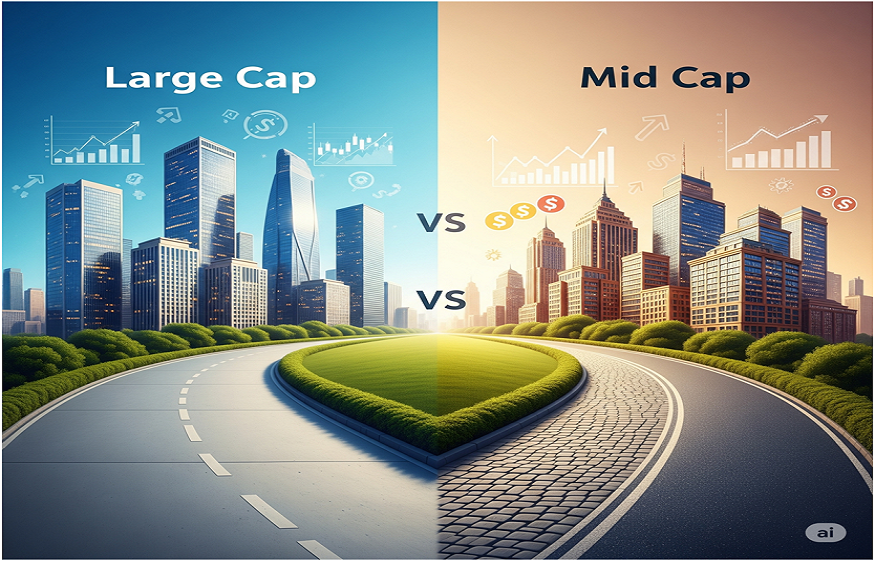Large Cap Funds vs Mid Cap Funds: Which Should You Choose?
Let me guess, you’re finally ready to do something smarter with your money. Maybe you’ve saved a little, or maybe you’ve stumbled into the magical world of mutual funds after a few too many hours on finance blogs. Either way, you’ve come across two mysterious creatures, Large Cap Funds and Mid Cap Funds, and now you’re stuck. Which one makes more sense for you?
You’re not alone. Seriously, this is one of those classic dilemmas that trip people up right at the doorstep of investing. The good news? There’s no one-size-fits-all answer. The bad news? Well… there’s no one-size-fits-all answer.
But stick with me, and we’ll dig through the noise together.
The Basics: What Are These “Caps” Anyway?
Before we start pitting these two against each other like some kind of financial boxing match, let’s take a breath and just break down what the heck “large cap” and “mid cap” even mean.
“Cap” here is short for “market capitalization.” It’s the total market value of a company’s outstanding shares. Imagine a big company like Reliance Industries. It’s worth trillions of rupees, which makes it a large cap. These are your big, stable giants that have been around, weathered storms, and probably show up in the news when the stock market sneezes.
Mid caps, on the other hand, are like the plucky younger siblings. They’re not tiny startups, but they’re not juggernauts either. They’re somewhere in the middle, think of them as companies that are still growing, sometimes fast, sometimes unpredictably. Sometimes thrillingly.
So when you invest in a large cap fund, you’re putting your money into a bunch of these big guys. A mid cap fund? You’re betting on the middle players with potential.
Sounds simple, right? It kinda is. But also, it kinda isn’t.
Stability vs. Growth: The Eternal Tug of War
Alright, here’s where it starts to get interesting.
Large cap funds are like the old friend who always shows up on time. They’re steady, they don’t throw surprises, and they’ve got a long track record. You might not get blown away by their performance, but you can usually count on them to not crash your financial car into a tree.
Mid cap funds? They’re exciting. They’re the rollercoaster in the amusement park. One year, they might outperform everything else in your portfolio. The next year… well, buckle up.
If you’re someone who loses sleep over red numbers in your investment app, large caps might be your safe zone. But if you’re willing to ride the waves and you’ve got time on your side, mid caps could reward your bravery.
Risk Appetite: Know Thyself
Now, here’s a question that doesn’t get asked enough: What kind of investor are you?
Not what kind you wish you were. Not what your cousin who made 45% returns last year tells you to be. What are you actually comfortable with?
Are you cool with short-term volatility if it means possibly higher long-term returns? Or does your stomach churn at the thought of losing even a rupee in a bad market month?
Because here’s the deal mid cap funds will test your nerves. The highs are higher, sure. But the lows? They can feel like freefall. Large caps are much more mellow, less whiplash-inducing.
So ask yourself: Can you emotionally and mentally handle seeing your investment dip 10-15% in a bad quarter? Will you panic and pull out, or will you hold steady?
If you’re not sure, it might be worth dipping a toe before diving in.
Time Horizon: Are You in a Rush?
Let’s talk timelines. When do you need this money?
If you’re planning to use your investments in the next couple of years, maybe for a house down payment, a big vacation, or starting your own business, then large cap funds might be your friend. They’re less likely to tank right when you need the cash.
Mid-cap funds are more like long-term relationships. You need to give them time. Five years, maybe more. That’s when the real magic happens, when the volatility starts smoothing out and the growth potential begins to shine.
It’s like planting a tree. If you keep digging it up every year to check the roots, it’ll never grow. But if you let it be, water it occasionally, and let nature do its thing, boom. Shade, fruits, the works.
Historical Returns: Numbers That Matter (Sort of)
Ah yes, the numbers. Everyone loves a good chart, right?
Historically, mid-cap funds have outperformed large-cap funds over long periods. That’s no secret. You’ll find plenty of data showing that mid caps have delivered 12-15% CAGR over the last decade or so, compared to 9-11% for large caps.
But and this is important those numbers don’t come in a straight line. Mid caps zig and zag. They can soar 40% in a great year… and fall 20% in a rough one.
Large caps, meanwhile, tend to move in slower, more predictable waves. Fewer surprises, fewer thrills.
So while the numbers are helpful, they don’t tell you everything. They definitely don’t tell you how you’ll feel during a market crash. And trust me, that feeling matters more than you think.
Real-Life Detour: My First Mid Cap Panic
The first time I invested in a mid cap fund, I was feeling confident. Cocky, even. The markets were up, I’d done “my research,” and the returns looked too good to pass up.
For the first few months, everything was sunshine. My portfolio grew faster than I’d ever seen. I felt like a genius.
Then came a market correction. Nothing dramatic in the news, just one of those random, inevitable downturns. Suddenly, my precious mid cap fund was down 12% in like three weeks. I panicked. I checked my app ten times a day. I seriously considered pulling out.
But I didn’t. I waited. I let it ride.
Two years later, that same fund had not only recovered but delivered nearly 30% growth overall. I learned something valuable: it’s not just about choosing the “right” fund. It’s about having the stomach for the one you choose.
Diversification: Why Not Both?
Here’s a thought: why choose at all?
Why not just… have both?
A balanced portfolio often includes a mix of large cap, mid-cap, and sometimes even small-cap funds. You don’t have to put all your eggs in one basket. You could have the steady base of large caps for stability, and sprinkle in some mid-caps for growth.
This approach isn’t flashy. It won’t make for exciting dinner party conversation. But it works. It smooths out the risk and still gives your money a shot at decent growth.
Think of it like a cricket team. You’ve got your dependable openers (large caps), your all-rounders (mid caps), and maybe a couple of high-risk sloggers (small caps or thematic funds). You need the mix to win the match.
Expense Ratios and Fund Management
Okay, quick pit stop on something most people ignore until it eats into their returns: expense ratios.
Large-cap funds often have slightly lower expense ratios. That’s because the underlying stocks are well-known, widely traded, and cheaper to manage.
Mid-cap funds, on the other hand, require a more active management approach. Fund managers have to do more legwork, more research, more strategic balancing. That often means slightly higher fees.
Does it matter? Over the long term, yes. Even a 0.5% difference in expense ratio can add up. But don’t obsess over it too much. A great mid-cap fund with a 1.5% expense ratio can still crush a mediocre large-cap fund with 1%. It’s not all about the fees; it’s about what you’re getting in return.
So… Which Should You Choose?
Let’s wrap this up with the question we started with: Large Cap Funds vs Mid Cap Funds Which One Should You Choose?
And the honest answer? It depends.
If you’re just starting, if you’re risk-averse, or if you have a short time horizon, large cap funds are a solid choice. They’re boring, but in a comforting, reliable kind of way.
If you’ve got time, a bit of courage, and a long-term goal in mind, then mid-caps could be worth the ride. They’re more volatile, sure. But they’ve got more room to run.
And if you’re not sure? Do what a lot of experienced investors do: build a mix. Let large caps be your anchor and mid-caps your sail. The wind will change, the tides will shift, but with both, you’ll probably stay on course.
Just remember: investing isn’t just about numbers and charts. It’s about knowing yourself, being honest with your limits, and playing the long game.
So go ahead, pick your funds. But more importantly, stick with them. That’s where the real returns come from.













Post Comment
You must be logged in to post a comment.